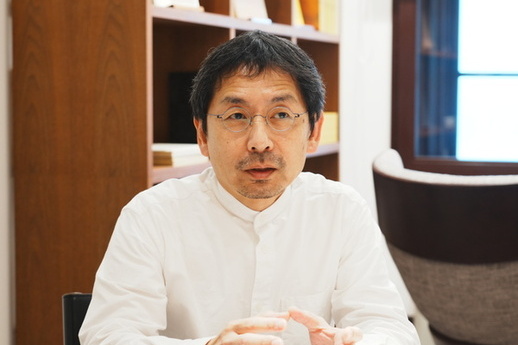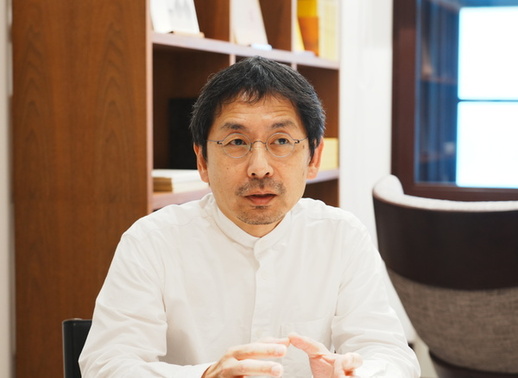2025.01.16
伝検ニュース新しい視点で石川から工芸文化発信 復興支援なお必要―国立工芸館の唐澤昌宏館長

インタビューに応じる国立工芸館の唐澤昌宏館長【時事通信社】
2020年に東京から金沢市へ移転した国立工芸館。輪島塗、九谷焼、加賀友禅といった漆芸、陶芸、染織の産地を多く抱える「工芸王国」で、一大観光地でもある石川県から、日本の工芸文化を発信し続けている。工芸の現状や今後の取り組みなどについて、同館の唐澤昌宏館長に聞いた。
―日本の工芸の現状をどう捉えているか。
現状を語る前提として、まず、日本の工芸には二つの担い手がいることを知っておいてほしい。個人作家と職人だ。われわれ工芸館が扱っているのは個人作家の作品であり、セレクトショップなどで販売されているのは、職人によって作られた工芸品というと、イメージしやすいかもしれない。
伝統工芸の担い手不足という問題を考えても、職人の世界では若い人の後継者が少ないが、個人作家はそうでもない。必要な技術そのものは、それぞれほぼ同じなので、双方のつながりや連携が密になれば、もっと(工芸を)盛り上げることができる。
―伝統文化・工芸の課題は何か。
伝統文化や工芸に関する情報発信は、いろいろな形で行われているが、パターン化していることも多い。新しい視点を持って、論議したり発信したりしないと、興味を持ってもらえない。工芸館でも工夫が必要だ。
―具体的には。
名前に「国立」とあるだけで、ハードルが高いと受け止められてしまうことがある。できるだけ多くの人に、ふらっと立ち寄ってもらえるようにしたい。コロナ禍では実施が難しかった対話型のトークイベントのような、もう少し来場者とじかに接するような機会をつくりたい。また、日本の工芸に影響を受けた、または、日本の工芸に影響を与えた海外の工芸作品を広く紹介する企画も検討したい。
―金沢市に移転して4年がたつ。
移転後、独立した一つの施設として興味を持ってもらえるようになった。石川県に来る観光客は、工芸に興味を持っている人も多く、国の施設があるなら立ち寄ってみようか、と足を運んでもらえている。熱心なお客さんが増え、館内での滞在期間が長くなった印象がある。
―石川県は2024年、地震、豪雨に見舞われた。
漆芸業界を支えている人を多く輩出している県立輪島漆芸技術研修所でも、地震や豪雨の被害は大きかった。そうした中でも、職員の皆さんは担い手を育てたいとの一心から、研修生に制作を続けさせ、12月には8カ月遅れの入学式も行われた。
一方、11月に金沢市で開かれた日本最大級の工芸イベント「KOUGEI EXPO IN ISHIKAWA」のような場に多くの人が集まりにぎわったが、「能登はまだまだ大変だ」という現状を知ってもらうことが大事だ。復興途上の様子を広めていくことができれば、支援もより広がると信じている。
【English version】
Showcasing craft culture from Ishikawa from a new perspective Support for reconstruction is still needed - Masahiro Karasawa, Director of the National Crafts Museum.

Masahiro Karasawa, director of the National Arts and Crafts Museum, is interviewed [Jiji Press].
The National Crafts Museum moved from Tokyo to Kanazawa in 2020. The museum continues to promote Japan's craft culture from Ishikawa Prefecture, a major tourist destination and a ‘craft kingdom’ with many lacquerware, ceramics and dyeing and weaving production areas such as Wajima lacquerware, Kutani ware and Kaga yuzen. We asked the museum's director, Karasawa Masahiro, about the current state of Japanese crafts and future initiatives.
-What is your view of the current state of Japanese crafts?
First of all, I would like you to know that there are two types of bearers in Japanese crafts: individual artists and craftspeople. There are individual artists and craftspeople. It may be easier to imagine that we at the Crafts Museum deal with the works of individual artists, while the crafts sold in select shops are made by artisans.
Even when considering the problem of a shortage of bearers of traditional crafts, there are few young successors in the world of craftspeople, but this is not the case for individual craftspeople. The skills required are almost the same in each case, so if there are closer links and cooperation between the two, it will be possible to boost (crafts) even more.
-What are the challenges of traditional culture and crafts?
Information on traditional culture and crafts is disseminated in various ways, but it often follows a pattern. If we don't discuss and transmit information from new perspectives, we won't get people interested. We need to be creative in the crafts halls.
-Specifically.
The mere mention of ‘national’ in the name can be perceived as a hurdle. We want to make it possible for as many people as possible to drop in on a whim. We would like to create opportunities for more direct contact with visitors, such as interactive talk events, which were difficult to hold at the Corona Disaster. We would also like to consider introducing a wide range of overseas craft works that have been influenced by Japanese crafts or have had an impact on Japanese crafts.
-It has been four years since we moved to Kanazawa.
Since the relocation, the museum has gained interest as an independent facility. Many tourists who come to Ishikawa Prefecture have an interest in crafts, and they are now visiting the museum, thinking that if there is a national facility, they should drop by. I have the impression that the number of enthusiastic visitors has increased and the length of stay in the museum has lengthened.
-Ishikawa Prefecture was hit by an earthquake and torrential rains in 2024.
The Prefectural Wajima Lacquer Art Technical Training Institute, which has produced many people who support the lacquer art industry, was also severely damaged by the earthquake and torrential rains. Despite the damage, the staff were determined to nurture the people responsible for the industry and allowed the trainees to continue with their work, and in December an entrance ceremony was held eight months after the earthquake.
Meanwhile, although many people gathered at places like the KOUGEI EXPO IN ISHIKAWA, one of Japan's largest craft events, which was held in Kanazawa in November, it is important for people to know that Noto is still in trouble. We believe that if we can spread the word about how the recovery process is going on, support will spread even further.
カテゴリー: 伝検ニュース





